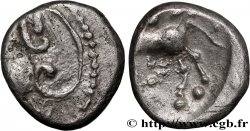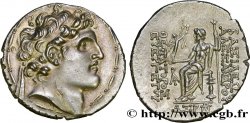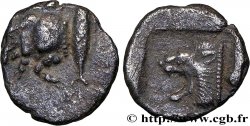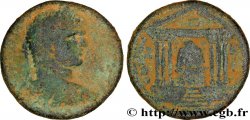v31_0798 - GALLIA - GALLIA DELLO SETTENTRIONALE - ÆDUI (BIBRACTE, Regione dello Mont-Beuvray) Denier à l’esse et à la lyre, tête bouclée
MONNAIES 31 (2007)
Начальная цена : 220.00 €
Назначить цену : 380.00 €
Цена реализации : 255.00 €
Количество ставок : 2
Максимальная предлагаемая цена : 421.00 €
Начальная цена : 220.00 €
Назначить цену : 380.00 €
Цена реализации : 255.00 €
Количество ставок : 2
Максимальная предлагаемая цена : 421.00 €
Тип Denier à l’esse et à la lyre, tête bouclée
Дата: c. avant 52 AC.
Монетный двор / Город: Autun (71)
Металл: silver
Диаметр: 13 mm
Ориентация осей монеты: 2 h.
Вес: 1,97 g.
Редкость: R3
Комментарии о состоянии
Flan relativement large, mais frappe décentrée au droit (sur l'avant du visage) et au revers (sur la tête du cheval). Fine patine grise, légèrement granuleuse
Ссылки в каталоге: :
Лицевая сторона
Аверс: легенда: ANÉPIGRAPHE.
Аверс: описание: Tête à droite, les cheveux en mèches bouclées.
Обратная сторона
Реверс: легенда: ANÉPIGRAPHE.
Реверс: Описание: Cheval galopant à droite ; lyre au-dessous et une esse au-dessus.
Комментарий
Ce denier constitue, dans le Nouvel Atlas, la var. 3 des "quinaires à la lyre" des Eduens. Le DT. 3185 est l'exemplaire de la BN illustré dans le LA TOUR (n° 4866). Le droit a la particularité d'avoir une chevelure simplifiée sans les mèches enroulées à leur extrémité comme c'est habituellement le cas. Les auteurs du Nouvel Atlas précisent que la hampe à la roue est analogue au revers du statère de Chenôves DT. 3175.
This denier constitutes, in the New Atlas, var. 3 of the \\\"quinaries with lyre\\\" of the Aedui. DT. 3185 is the copy of the BN illustrated in the LA TOUR (no. 4866). The obverse has the particularity of having simplified hair without the locks rolled at their ends as is usually the case. The authors of the New Atlas specify that the shaft with the wheel is analogous to the reverse of the Chenôves stater DT. 3175
This denier constitutes, in the New Atlas, var. 3 of the \\\"quinaries with lyre\\\" of the Aedui. DT. 3185 is the copy of the BN illustrated in the LA TOUR (no. 4866). The obverse has the particularity of having simplified hair without the locks rolled at their ends as is usually the case. The authors of the New Atlas specify that the shaft with the wheel is analogous to the reverse of the Chenôves stater DT. 3175








 Cообщить об ошибке
Cообщить об ошибке Распечатать страницу
Распечатать страницу Отправить мой выбор
Отправить мой выбор Задать вопрос
Задать вопрос Consign / sell
Consign / sell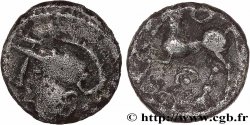
 Информация
Информация

